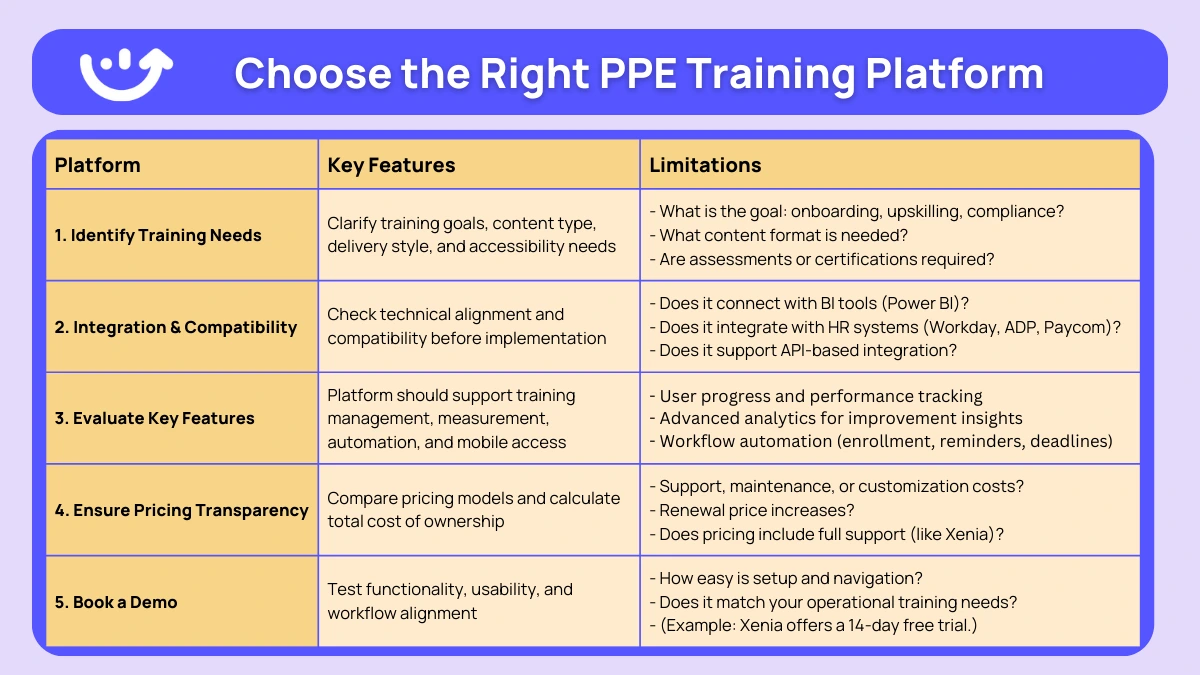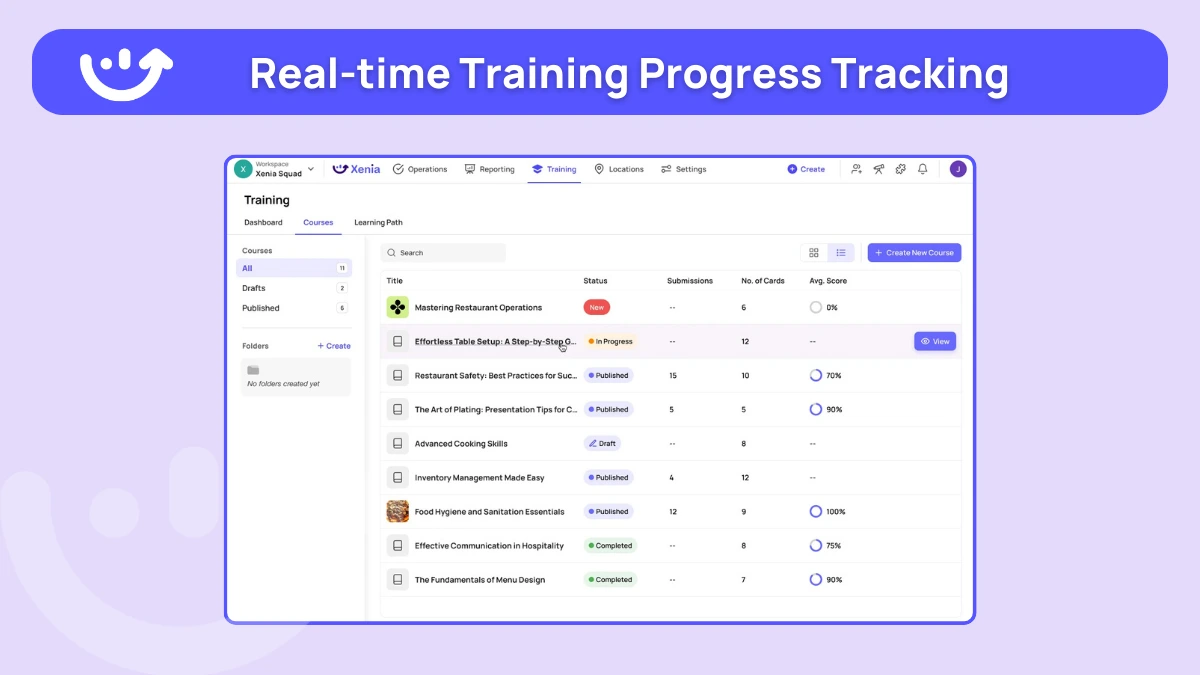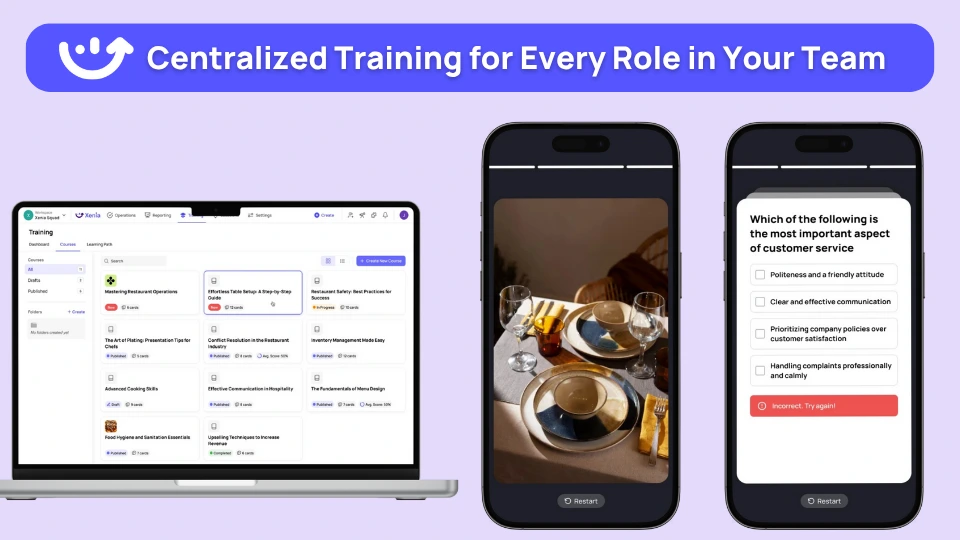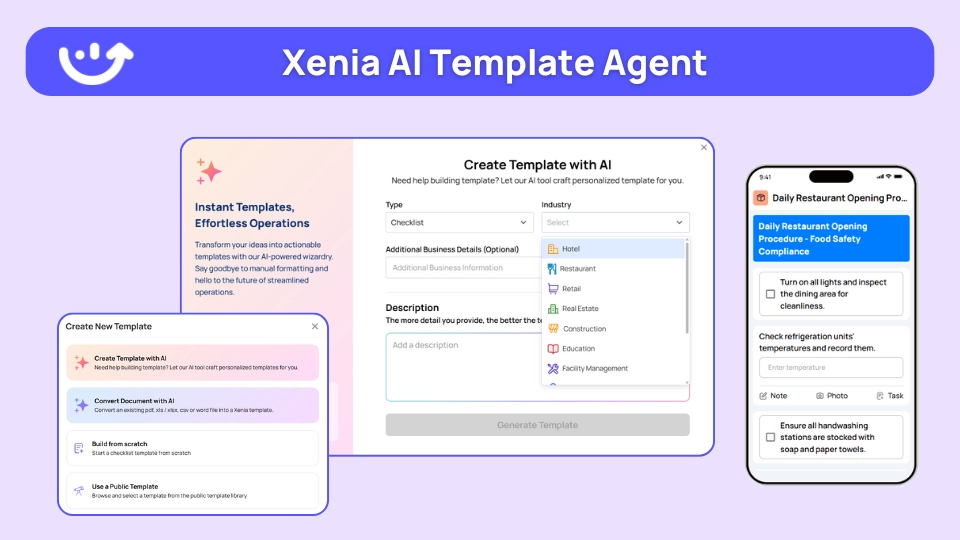What if for every 10 injuries reported in your workplace, you could drop it down to 6? According to a report, the use of PPE enabled a manufacturing company to achieve its goals.
In fact, the incident rates can fall even further if your employees understand what, when, and how to use PPE properly.
However, with shifting roles, frequent task updates, or different shifts, how do you ensure the teams are using the protective gear correctly?
To ensure this, you can ensure that every worker is aware of the risks involved, the importance of PPE, and how to use it correctly. While PPE training is utterly important, how you structure the courses makes a great difference.
Most frontline teams now use a structured and automated process for complying with the PPE needs, and let’s find out why.
.svg)

Priced on per user or per location basis
Available on iOS, Android and Web
Is Manual PPE Training Management Still Relevant?
Suppose company A has trained its employees on the PPE requirements for handling chemicals or heavy machinery, while company B still relies on manual training, often skipping important steps.
Company B is likely to have employees making more mistakes & errors, which require more time for troubleshooting and repeating tasks. This example clearly shows that having PPE training is not enough; it is how effectively you implement it that makes the difference.

Let’s see why manually managing PPE can affect your overall operational excellence.
- If you are still manually training your employees, it could work for one site. However, across different sites, manual training often yields inconsistent learning materials and assessments. Read: How to Manage Training Across Multiple Locations
- There is no real-time visibility into data that has been trained or which training certifications have expired.
- With manual training, customizing learning materials to your industry and equipment can be time-consuming and challenging.
- Manual training often offers no immediate support. Let's say a worker gets stuck while operating a machine. With manual training, there is no on-demand accessibility, which slows down work and affects overall productivity.
- The outdated manual training programs might cost you more, including hiring trainers, printing materials, and halting operations while the teams undergo their training.
- With manual systems, training sessions depend on physically scheduling, sending reminders, and managing paperwork, which can be significantly reduced with automated training tasks.
- Manual training, particularly for multi-site operations, can lead to inconsistent quality, resulting in increased safety incidents, such as PPE misuse or improper machine handling.
- The data records are not entirely accurate, with missing files, mismatched dates, and incomplete attendance sheets, which can result in fines and compliance violations.
What Automation Looks Like in Digital PPE Training
According to a report shared by OSHA, training with structured programs results in a 50% reduction in workplace injuries. With the help of an LMS or PPE training software, you can make a structured path of learning by:
- Organizing Content into a Logical Path: With the PPE training management system, you can arrange the course materials in a specific order, making it easier for learners to understand the sequence of content. [Module 1-> Module -> Module 3]
- Controlling the Pace and Progress: In the training course, you can set prerequisites (such as requiring completion of Module 1 before starting Module 2) or specify required passing scores to get the certificate.
- Standardizing Training for Everyone: The LMS ensures that workers receive the same content from the same trainer, thereby maintaining a consistent learning experience throughout. Across all locations, workers receive the same videos, checklists, quizzes, and procedures.
- Tracking Competency and Skills Completion: If you are digitally training instead of one-on-one training, tracking performance becomes simpler. You don’t have individual performance reports for every worker, but LMS lets you track the progress for every worker in one place with its live dashboards. With custom dashboards, managers can track key metrics, including completion rates, active user counts, time-to-completion, average scores, pass/fail rates, and overall performance.
- Supporting Certification and Compliance: The LMS can automatically issue certificates, track expiration dates, send reminders, and store audit-ready training records, which is crucial for effective compliance management.
PPE Compliance Automation Across Shifts
Frontline LMS ensures that all employees on every work shift are trained, certified, & comply with standards as needed by OSHA and other compliance requirements. Here's how exactly this happens:
- The training modules are standardized with PPE training systems, meaning that all employees, regardless of shift, follow the same standards.
- By delivering automated training modules for onboarding and ongoing refresher courses, all employees get the same course material on PPE usage and safety regulations.
- The modern frontline LMS tools continuously monitor operations, gather data, and are capable of reporting any deviations or regulatory gaps in training requirements.
- With built-in notification systems in the LMS, managers can provide channels for addressing any doubts or challenges workers face digitally.
How to Automate Training Across the Full Employee Lifecycle
Now, let’s find out how to execute automation using digital tools for your operational needs.
1. Onboarding
As a new employee is added to the workforce, managers (with the help of the digital PPE software) can automate the learning paths for new team members. This ensures that every new worker undergoes training with all the necessary safety protocols and procedures.
2. Assigning Tasks and Modules
Once the new employee is onboarded, the training software automatically assigns course materials, such as modules on hearing protection and chemical-resistant gear, based on their roles. You can custom-build and automate course modules based on role, shift, or task, with recurring modules scheduled to maintain ongoing compliance.
3. Completion
To determine if the courses are helpful, managers can assign assessments, such as quizzes, digital checklists, forms, assignments, or tests, within the learning path using the training software, which evaluates and tracks performance.
4. Verification
- At the end of every video or module, workers can upload photos or videos in real-time to demonstrate proper PPE use or task execution.
- You can build digital checklists using the LMS that integrate weighted scoring, providing a total score upon completion. You can do this both before and after training, and then compare the results.
- To verify whether workers have actually completed the courses, the LMS provides you with data that you can break down by users' activity, including details such as their log-in time, frequency, and total time spent.
- Using digital forms built using the PPE training software, you can collect feedback on how effective the training was for team members.
Operational Outcomes of Automated PPE Training
- Repetitive tasks, such as certification renewal or tracking attendance for training sessions, can be automated, saving time and reducing operational costs.
- Workflows for onboarding new employees become faster and more streamlined.
- Improved shift readiness as the workers know which PPE to use for their tasks and have instant access to guidance, SOPs, and instructions whenever needed.
- Workers are trained and certified, which means fewer mistakes and safety incidents, resulting in reduced delays & downtime.
- With real-time tracking and automated updates, managers get transparency and visibility of training compliance.
How to Choose the Right PPE Training Automation Platform
Now comes the most important question: How do I find a digital PPE training platform that meets my operational needs? For this, we have the following checklist for you.

1. Identify Training Needs
Only when you know your training requirements can you choose the platform that best suits your needs. Before you begin researching the training platforms, you must have the answers to the following questions.
- What is the goal of the training? Is it training, onboarding, upskilling, or compliance?
- What type of content will be covered in the learning modules?
- What assessment and testing features does my workflow need?
- What will be the approach? Will there be defined learning timelines, or would you like to give employees a flexible timeframe to learn?
- What will the accessibility be: desktop, tablet, or mobile learning?
2. Consider Integration & Compatibility
The PPE training software you select must work seamlessly with other systems your organization uses, without affecting operations or compromising data quality. Check the software's integration capabilities with:
- HR systems (such as Workday, ADP, Paycom, & Paylocity)
- Business Intelligence tools (like Power BI)
- Third-party systems (including POS systems, file storage apps, auditing tools, and IT help desks).
Pro tip: Choose a software that integrates an API, which makes communication, data sharing, and automating workflows seamless for separate tools used by your business.
3. Evaluate Key Features
Some of the key features you can’t miss when selecting a frontline LMS are:
- Centralized Course Management: The platform should be capable of storing & organizing learning materials, tracking employees' progress, maintaining training records, and integrating training assessments. This way, there are no scattered training materials, with no missed logs, certifications, or employees' details.
- Assessments & Certifications: The platform should enable the creation of assessments, including quizzes, tests, PPE certification tracking, and other evaluations, allowing users to obtain certifications upon completing training.
- Performance Tracking: The frontline LMS should be capable of tracking and monitoring user performance.
- Advanced Analytics: The analytical tools should provide insights into which courses are effective, learning path analysis, and skill development metrics, so you know the training programs are actually helping users.
- Automation: The LMS must support the automation of tasks such as updating user status, enrolling users in subsequent courses within the learning path, or sending notifications for deadlines, assignment submissions, and other relevant events.
- Onboarding: The LMS should provide a seamless onboarding experience, offering users role-based learning paths tailored to their specific needs and requirements.
- Mobile-access with Easy Availability: Your employees can access mobile PPE training modules at any time. When a machine is stuck or not working, workers can simply scan the QR code to access a training or tutorial video.
4. Ensure Pricing Transparency
The cost of the training platform you choose is a critical factor to consider. When choosing a learning platform, identify any additional costs, which may include:
- Implementation costs
- Onboarding & training costs
- Support & maintenance costs
- Integration/customization costs
- Price hikes upon renewals
- Module add-on costs
To make the platform more affordable for your business needs, it is best to choose a platform that has no hidden fees, like Xenia. You get full implementation, training, and customer support with no additional fee.
Also, check the pricing plans offered by Xenia on a per-site and per-user basis.
5. Book a Demo
Before purchasing a PPE training compliance platform for your team, it is best to request a demo to ensure it meets your operational needs. Most training management platforms offer a free demo, free trials, or charge a minimal fee to try out their features first.
For instance, Xenia offers a 14-day free trial to test out all the training capabilities.
Xenia: Best PPE Compliance Automation Tool
Xenia is a cloud-based PPE training software designed for quick and easy access to learning materials.
With Xenia, you can automate training-related tasks, such as scheduling upcoming courses for teams, notifying users when certifications expire, and more.
Let's learn how Xenia can help you train your teams from the same platform where you manage your frontline operations.
Automated Progress Tracking
The LMS tracks the progress of each employee/trainee, including which module is completed, quiz/assessment scores, and certification status.

Automated Reminders and Alerts
Trainees receive automated alerts for overdue tasks, expiring certifications, and other notifications related to training materials, submissions, feedback, and other relevant training updates.
Automated Scheduling
Managers and supervisors can initiate training pathways for all sites when new machinery or work processes are introduced to the operations.
Role-based Trainings
Managers can automate course assignment based on specific roles. For every new hire, you don't need to set up the course manually; the system will directly assign the course based on the role.
For example, for a medical assistant, you can upload bite-sized modules to the LMS, digital checklists with step-by-step guides, and implement assessments for the following:
- Patient Communication & Professionalism
- Infection Control & PPE Usage
- Clinical Procedures & Equipment Handling
- Recordkeeping & Electronic Health Systems
- Emergency Protocols & Safety
Now, every time a new medical assistant gets hired, the training process will be automated by the LMS.

Automated Recurring Trainings
For recurring training-related requirements, such as fire drills or PPE Usage Refreshers, you can schedule them with custom intervals as needed.
Integrated Digital Checklists
With digital checklists, you can provide learners with a structured and detailed roadmap for their learning. The digital checklists, built by an AI template builder in seconds, enable you to integrate videos and photos, ensuring effective learning with engaging and gamified content.

AI-driven Analytics
Using historical data from all operations, Xenia provides managers with insights that help identify training gaps and opportunities for improvement.
Upon identifying which teams require training or which equipment employees are having trouble operating, you can initiate training courses accordingly.

Break Down Long Courses: Micro-Learning
Give your employees an hour-long video, and they won't really learn from it. Instead, Xenia lets you upload short, TikTok-style videos that are actually useful.
Let's say a worker doesn't know how to wear new safety gear. In that case, the worker can scan a QR code and quickly learn in just a minute.

Automatic Translation
Xenia offers automatic translation features with its outstanding multi-lingual capabilities.
Next Steps
Automated PPE training ensures that every employee knows how to stay safe in high-risk environments that frontline operations often present. By reducing repetitive tasks, boosting shift readiness, and improving safety, compliance can become simpler and more streamlined.
Find out how you can make workers more confident in your workplace with a free demo.

.svg)
.webp)
%201%20(1).webp)






.svg)
%201%20(2).webp)








